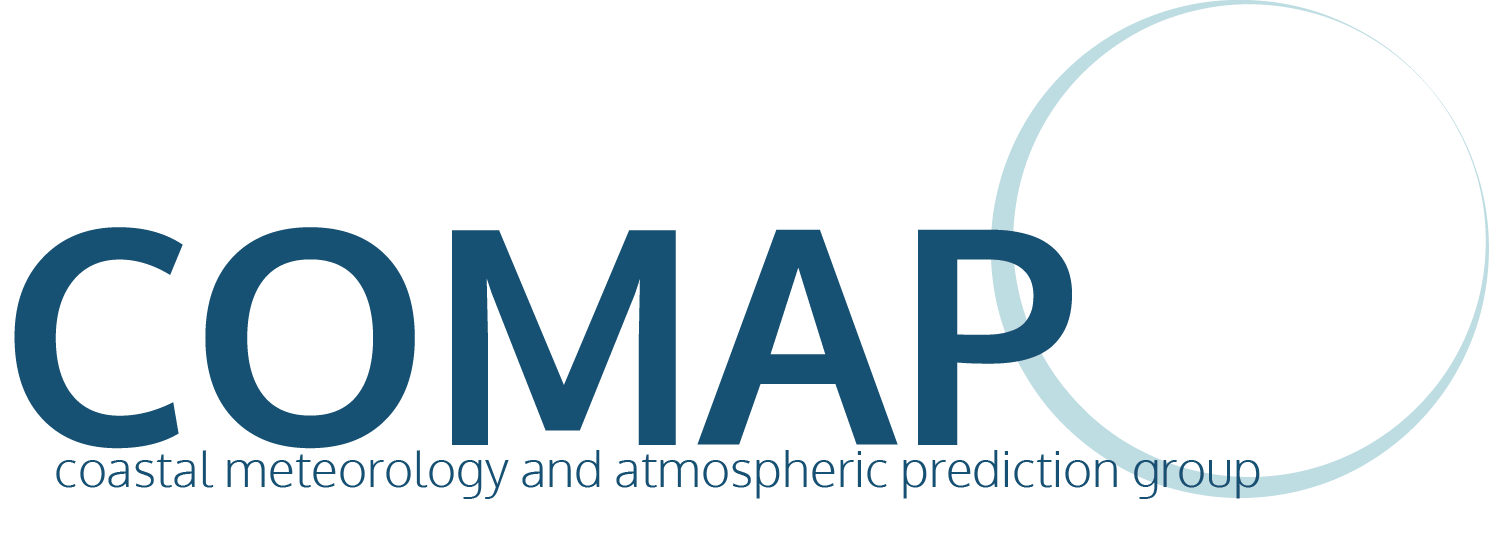Data Assimilation
What is the Ensemble Kalman Filter?
The true state of the atmosphere at any given time is subject to a large amount of uncertainty. Observations can reduce this uncertainty, although observations can be difficult to come by. On the flip side, atmospheric model output has the advantage of data availability (on a grid), but is plagued by biases and model error. The Ensemble Kalman Filter (EnKF) blends short term model data and observations to create a more accurate gridded analysis than either the model or observations separately. This is the general idea behind most modern data assimilation techniques, which are used to initialize atmospheric models or create reanalysis products.
A strong advantage of the EnKF with the use of an ensemble of atmospheric models to estimate flow dependent error structures. To visualize how this works, imagine a single observation over Long Island assimilated into a short-term model forecast, as shown in the figure below. The model generated forecast was too cold and therefore the new observation results in a warmer analysis. How the new observation should impact the new analysis is not always obvious. A common data assimilation technique known as 3DVAR would spread this warming isotropically (i.e. equally in all directions), but this may not be realistic. In this particular case (from Whitaker and Hamill), the observation was assimilated out ahead of a warm front. Since Long Island was warmer than forecast, this might suggest that the speed of the warm front is faster, and this affect should be properly represented in the new analysis. Since the EnKF uses many different members, each having their own unique warm frontal speed, the new analysis generated by the EnKF is more realistic.
Research with Ensemble Kalman Filter
COMAP uses the EnKF developed at Pennsylvania State University (PSU) coupled to the Weather Research and Forecast (WRF) model. Currently the WRF-EnKF system is used to explore and correct model bias and error on days exhibiting significant fire threat risk as determined from a fire weather index. For more details on the fire weather index, please click here. In short, model simulations of fire weather days exhibit greater biases than the seasonal average, particularly with temperature and moisture. The EnKF is being run on fire weather days to quantify and correct this bias, either with post-processing or internally in the model.
To illustrate the impact of assimilating observations and the EnKF, let’s take a look at one specific case on April 9th, 2012 at 2 pm. The domain for the WRF-EnKF system and the observations assimilated are shown in figure a) below. In general, over 30,000 observations are assimilated every 6 hours over a domain spanning the eastern two-thirds of the country. During this case, the fire weather index was very high and a large wildfire developed on Long Island. Consequently, the short-term model forecast from this time exhibited large bias that was corrected by assimilating observations. The near-surface temperature bias is shown in figure b) before observations were assimilated. The cold bias is striking, particularly over the NYC region. After the observations, were assimilated, this bias is largely eliminated.

When considering the EnKF over many iterations, its performance on fire weather days versus non-fire weather days is quite apparent, as shown in figures d) for bias and e) for mean absolute error. High fire threat days are colder than normal, especially in the boundary layer, but the EnKF eliminates most of this bias regardless of the m agnitude. As a result, the EnKF reduces the error in the WRF forecast (particularly on fire weather days) to be comparable to or better than the Rapid Update Cycle (RUC) analysis. This is an encouraging result that we hope to improve upon using more observations.
agnitude. As a result, the EnKF reduces the error in the WRF forecast (particularly on fire weather days) to be comparable to or better than the Rapid Update Cycle (RUC) analysis. This is an encouraging result that we hope to improve upon using more observations.
Currently, we are using the EnKF to explore potential sources of model error within the parameterized model physics of the WRF model. More specifically, the filter will be used to both simultaneously estimate the optimal analysis and specific parameters embedded in the ACM2 PBL scheme. Our goal is to seek out potential structural model errors that might be responsible for model biases on days where fire development risk are high.
Details of COMAP Data Assimilation Projects
Employing ensemble data assimilation, parameter estimation, and field data to improve fire weather predictions in mesoscale models. [August 2010 – present]
- Quantify and correct model biases specific to fire weather days over the Northeast United States.
- Use cluster analysis as an objective method for separating “weather patterns.”
- Use data assimilation to elucidate and correct model errors.
Operational fire weather website available here.
Project Supported by the United States Forest Service (USFS).
Presentations
Erickson, M.J, and B.A. Colle. “Using the Ensemble Kalman Filter on Fire Weather Days to Explore Model Error over the Northeast United States.” AMS 23rd Conference on Numerical Weather Prediction. July 2015. Chicago, IL (Oral presentation).
Erickson, M.J, J.J. Charney, and B.A. Colle. ”Exploring Ensemble Kalman Filter Performance on Fire Weather Days over the Northeast United States.” 11th Symposium on Fire and Forest Meteorology. May 2015. Minneapolis, MN. (Oral Presentation).
Erickson, M.J. and B.A. Colle. “Using an Ensemble Kalman Filter to Explore Model Performance on Northeast U.S. Fire Weather Days.” National Weather Service Northeast Regional Operational Workshop. November 2014. Albany, NY. (Virtual Oral Presentation).
Erickson, M.J. and B.A. Colle. “Exploring Model Error with an Ensemble Kalman Filter on High Fire Threat Days over the Northeast United States.” The 6th Ensemble Kalman Filter Data Assimilation Workshop. May 2014. Buffalo, NY. (Poster Presentation).
Students Involved
Michael Erickson (2012-present). Contact at michael.erickson@stonybrook.edu

